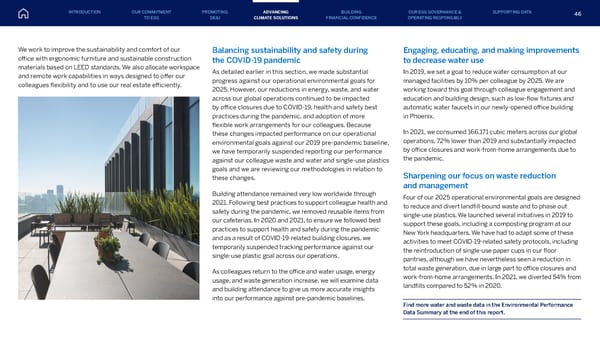We work to improve the sustainability and comfort of our office with ergonomic furniture and sustainable construction materials based on LEED standards. We also allocate workspace and remote work capabilities in ways designed to offer our colleagues flexibility and to use our real estate efficiently. Balancing sustainability and safety during the COVID-19 pandemic As detailed earlier in this section, we made substantial progress against our operational environmental goals for 2025. However, our reductions in energy, waste, and water across our global operations continued to be impacted by office closures due to COVID-19, health and safety best practices during the pandemic, and adoption of more flexible work arrangements for our colleagues. Because these changes impacted performance on our operational environmental goals against our 2019 pre-pandemic baseline, we have temporarily suspended reporting our performance against our colleague waste and water and single-use plastics goals and we are reviewing our methodologies in relation to these changes. Building attendance remained very low worldwide through 2021. Following best practices to support colleague health and safety during the pandemic, we removed reusable items from our cafeterias. In 2020 and 2021, to ensure we followed best practices to support health and safety during the pandemic and as a result of COVID-19-related building closures, we temporarily suspended tracking performance against our single-use plastic goal across our operations. As colleagues return to the office and water usage, energy usage, and waste generation increase, we will examine data and building attendance to give us more accurate insights into our performance against pre-pandemic baselines. Engaging, educating, and making improvements to decrease water use In 2019, we set a goal to reduce water consumption at our managed facilities by 10% per colleague by 2025. We are working toward this goal through colleague engagement and education and building design, such as low-flow fixtures and automatic water faucets in our newly-opened office building in Phoenix. In 2021, we consumed 166,171 cubic meters across our global operations, 72% lower than 2019 and substantially impacted by office closures and work-from-home arrangements due to the pandemic. Sharpening our focus on waste reduction and management Four of our 2025 operational environmental goals are designed to reduce and divert landfill-bound waste and to phase out single-use plastics. We launched several initiatives in 2019 to support these goals, including a composting program at our New York headquarters. We have had to adapt some of these activities to meet COVID-19-related safety protocols, including the reintroduction of single-use paper cups in our floor pantries, although we have nevertheless seen a reduction in total waste generation, due in large part to office closures and work-from-home arrangements. In 2021, we diverted 54% from landfills compared to 52% in 2020. Find more water and waste data in the Environmental Performance Data Summary at the end of this report. INTRODUCTION PROMOTING DE&I ADVANCING CLIMATE SOLUTIONS BUILDING FINANCIAL CONFIDENCE OUR ESG GOVERNANCE & OPERATING RESPONSIBLY SUPPORTING DATA OUR COMMITMENT TO ESG 46
 American Express ESG Report Page 45 Page 47
American Express ESG Report Page 45 Page 47